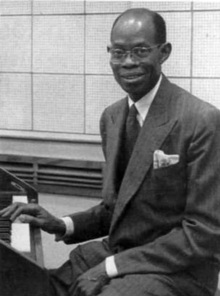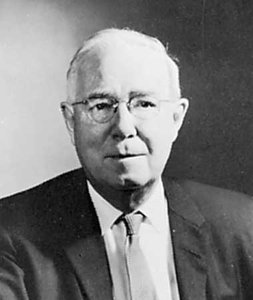Related Research Articles

Horatio William Parker was an American composer, organist and teacher. He was a central figure in musical life in New Haven, Connecticut in the late 19th century, and is best remembered as the undergraduate teacher of Charles Ives while the composer attended Yale University.

Chief Olufela Obafunmilayo "Fela" Sowande MBE was a Nigerian musician and composer. Considered the father of modern Nigerian art music, Sowande is perhaps the most internationally known African composer of works in the European "classical" idiom.

John Gavin Scott was an English organist and choirmaster who reached the highest levels of his profession on both sides of the Atlantic. He directed the Choir of St Paul's Cathedral in London from 1990 to 2004. He then directed the Choir of Men and Boys of Saint Thomas Church on Fifth Avenue in New York City until his death at age 59. Whilst training countless young musicians, he maintained an active career as an international concert performer and recording artist, and was acclaimed as "the premier English organist of his generation".

Thomas Tertius Noble was an English-born organist and composer, who lived in the United States for the latter part of his career.

Dudley Buck was an American composer, organist, and writer on music. He published several books, most notably the Dictionary of Musical Terms and Influence of the Organ in History, which was published in New York City in 1882.
Alfred Ernest Whitehead was an English-born Canadian composer, organist, choirmaster, music educator, painter, whose works are held in a number of important private collections, and an internationally recognized authority in the field of philately. His The Squared-Circle Cancellations of Canada received its third edition shortly after his death.

Leo Salkeld Sowerby was an American composer and church musician. He won the Pulitzer Prize for music in 1946 and was often called the “Dean of American church music” in the early to mid 20th century.
Peter John Hurford OBE was a British organist and composer.

Sir John Frederick Bridge was an English organist, composer, teacher and writer.

Frederick Lewis Swann was an American church and concert organist, choral conductor, composer, and president of the American Guild of Organists. His extensive discography includes both solo organ works and choral ensembles he has conducted.

Paul Smith Callaway, was a prominent American organist and choral conductor, particularly well known for his thirty-eight years at the Washington National Cathedral, Washington, D.C., between 1939–1977. A friend of Leonard Bernstein and Ned Rorem, he was also active in opera and a frequent guest conductor of the Lake George Opera Company and was the founding musical director of the Opera Society of Washington in 1956, now the renowned Washington National Opera. By the time of his death in 1995, he was acclaimed for his great influence on the musical life of the nation's capital. In 1977, Callaway was appointed an Honorary Officer of The Order of the British Empire (OBE) and invested by Ambassador Peter Jay on behalf of Queen Elizabeth II.
John Ernest Cook was an Anglo-American organist, composer and church musician.
Frederick Flaxington Harker (1876–1936) was an American organist and composer of sacred music.

Paul Ambrose was a Canadian organist, conductor, composer, and music educator who was primarily active in the United States. His compositional output includes more than 200 songs, choral pieces, and works for solo piano and organ. He is particularly remembered for his anthems, which have been performed widely in North America. Some of his better-known works include the anthems Saviour, Breathe an Evening Blessing, O Little Town of Bethlehem, and Come unto Me; and the song Rose-Bud.
Joseph Humfrey Anger was a Canadian organist, pianist, conductor, composer, and music educator of English birth. His compositional output consists mainly of church music and works for solo piano and organ. Some of his more well known works are A Concert Overture for organ (1895), the patriotic song Hail Canada (1911), and Tintamarre, Morceau de Salon (1911), all of which were published by Whaley, Royce & Co. The latter piece was notably the first published classical composition to thoroughly integrate true tone clusters. He also wrote the textbooks Form in Music and A Treatise on Harmony, both of which were widely used in music schools in North America.
William Reed was a Canadian organist, choir conductor, and composer. He held numerous organ and choirmaster posts in churches throughout Canada from 1884 until 1913. His career in this area was cut short as his deafness worsened. He spent the remainder of his career composing and contributing articles to music periodicals like The Etude. His compositional output mainly consists of sacred works, including many anthems and works for solo organ. His more well known works include the Christmas cantata The Message of the Angels (1910), the cantata The Burden of the Cross (1912), the Easter cantata The Resurrection and the Life (1911), and the Grand Choeur in D for organ (1901). His pupil Henri Gagnon considered the latter work "one of the very best Canadian compositions".
Henry Houseley FRCO was an English organist, composer and teacher, who moved to Denver, Colorado.

Peter Christian Lutkin was an American organist, choral conductor, and composer.
Harold Friedell was an American organist. He was well known as a performer and educator, teaching at Juilliard and Union Seminary, a composer of a large number of choral anthems and solo organ pieces, and as a prominent leader in the American Guild of Organists.

Emma Louise Ashford was an American organist, composer, and music editor. She wrote over 600 compositions. From 1894 to 1930 she was an editor at Lorenz Publishing Company, and at its periodicals The Choir Leader and The Organist.
References
- ↑ Immigration records from Candlyn's entry at the port of Boston 22 August 1931